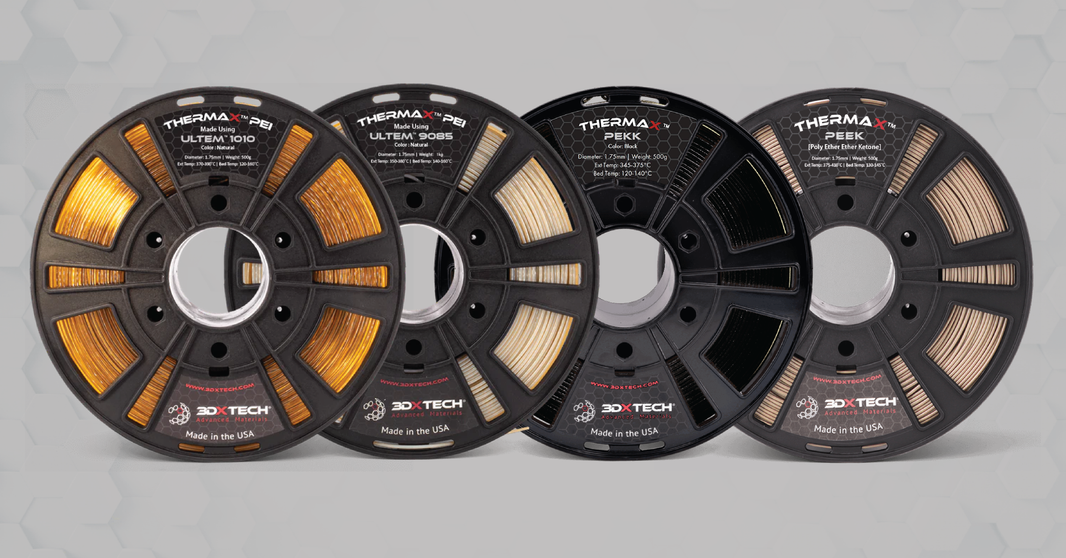End-Use Parts with High-Performance Filaments: Bridging Prototyping and Production
Engineering teams are moving beyond mockups. With high-performance filaments like PEEK, PEKK, Ultem™ (PEI), PPSU, PSU, and PC, additive manufacturing delivers production-ready end-use parts—fast, repeatable, and compliant with demanding environments. From Prototype to Production—What Changed?
- Performance Polymers with continuous-use temps up to ~250 °C and excellent chemical resistance.
- Compliance Options with UL94 V-0, aerospace FST considerations, and industry-specific requirements.
- Economics Cost-effective short runs and spares—no molds required.
Where End-Use AM Parts Shine
- Aerospace: Avionics brackets, cable guides, interior panels, and ground-support tooling that demand heat and flame performance.
- Automotive: Under-hood clips, sensor mounts, ducting, and assembly aids with thermal and chemical exposure.
- Defense: Rugged housings, connectors, field-service spares, and EMI-friendly enclosures (with appropriate material selection).
- Industrial Manufacturing: Custom jigs, fixtures, and tooling, end-of-arm tooling, guides, and guards for harsh factory conditions.
- Oil & Gas / Energy: Chemical-resistant manifolds, inspection fixtures, and high-temp brackets.
Material Playbook: Choosing the Right High-Performance Filament
| Material | Key Strengths | Common End-Use Parts |
|---|---|---|
| PEEK | Ultra-polymer; continuous-use up to ~250 °C; exceptional chemical & wear resistance; high strength. | Structural brackets, pump components, insulating bushings, chemical-contact hardware. |
| PEKK | PEEK-class performance with tunable crystallinity; excellent thermal stability and processability. | Precision housings, clips, ducting, aerospace & defense components. |
| Ultem™ (PEI) | High heat, inherent flame resistance (UL94 V-0), dimensional stability, dielectric properties. | Cabin components, electrical enclosures, fixtures near heat sources. |
| PPSU | Excellent hydrolysis & chemical resistance; high impact; sterilizable; good long-term heat aging. | Manifolds, fluid-handling parts, durable housings, interior aircraft components. |
| PSU | High heat deflection, flame resistance, dimensional stability, good dielectric strength. | Industrial housings, guards, connectors, under-hood components. |
| PC (Polycarbonate) | High impact resistance, clarity (in some grades), stiffness, heat resistance. | Machine guards, covers, brackets, functional fixtures. |
Need static control? See our ESD-Safe Filaments. Need flame compliance? See Flame-Retardant Filaments.
Design & Production Best Practices
Design for Additive (DfAM)
- Orient for load paths, minimize support, use filleted transitions; lattice infill where weight matters.
- Integrate fasteners/bosses; consider inserts for repeated torque.
Process Control
- Use enclosed, high-temp printers; dry filaments; verify chamber temps for ultra-polymers.
- Quantify properties via test coupons (tensile, HDT, chemical soak) before fleet rollout.
Quality & Compliance
- Document material lot, print parameters, and post-processing (anneal, machining, inspection).
- Match requirements (e.g., UL94, FST, dielectric strength) to the application’s environment.
When to Choose AM for End-Use Parts
- Low-to-mid volumes: Avoid tooling costs, enable rapid ECOs.
- Complex geometries: Internal channels, consolidated assemblies, weight reduction.
- Spare parts & obsolescence: Digital inventory, fast turn for service and MRO.
Example Workflows
- Tooling → End-Use: Validate with jigs/fixtures, then migrate geometry to production-grade materials (PEEK/PEKK/PEI).
- Prototype → Pilot Run: Print 5–100 units for field trials; collect performance data; lock parameters; scale.
- Variant Manufacturing: Quickly produce custom brackets/housings by swapping inserts or parametric CAD.
Conclusion
High-performance filaments—PEEK, PEKK, Ultem™ (PEI), PPSU, PSU, and PC—let engineering teams ship real parts, not just prototypes. With the right design rules, process control, and compliance checks, additive manufacturing becomes a reliable path to durable, production-ready end-use parts across aerospace, automotive, defense, and industrial manufacturing.






